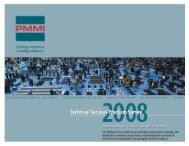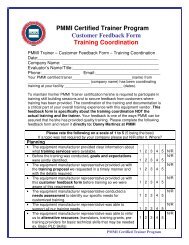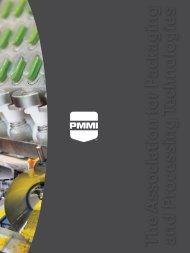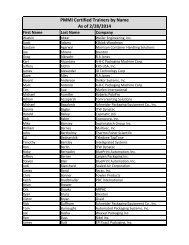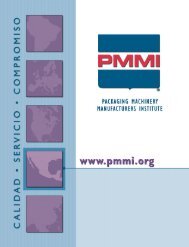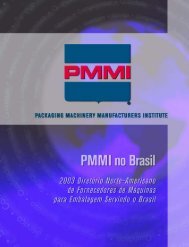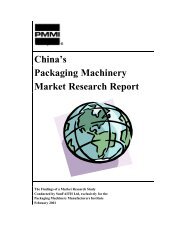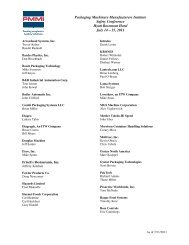Canadian Packaging Machinery Market Research Report - PMMI
Canadian Packaging Machinery Market Research Report - PMMI
Canadian Packaging Machinery Market Research Report - PMMI
Create successful ePaper yourself
Turn your PDF publications into a flip-book with our unique Google optimized e-Paper software.
1.0 THE CANADIAN MARKET ENVIRONMENT<br />
1.1 INTRODUCTION<br />
Canada has an affluent economy that is closely integrated with that of the United<br />
States, resembling not only U.S. per capita output, but also its market-oriented<br />
economic system, pattern of production, and high standard of living. In the years<br />
since the Second World War, impressive growth in the manufacturing and service<br />
sectors has transformed the nation from a largely rural economy into one primarily<br />
urban and industrial; although much of Canada’s manufacturing sector, including<br />
many purchasers of packaging machinery, is owned by American companies. The<br />
1989 U.S.-Canada Free Trade Agreement (FTA) and the 1994 North American Free<br />
Trade Agreement (NAFTA), which includes Mexico, eliminated virtually all <strong>Canadian</strong><br />
tariffs on U.S. products and touched off a dramatic increase in trade and economic<br />
integration with the U.S. Economically and technologically, Canada has developed in<br />
parallel with the United States across an undefended border.<br />
It is difficult to isolate the precise effects of any trade agreement on economic growth,<br />
but NAFTA’s numbers are impressive. By the fifth anniversary of the agreement,<br />
Canada’s merchandise trade with the U.S. and Mexico had risen 80 per cent and 100<br />
per cent, respectively. By 1999, trade in goods and services between Canada and<br />
the U.S. totaled $622.7 billion—an average of $1.7 billion of business crossing the<br />
border every day. The dominance of the U.S. in the Country’s trade statistics is<br />
striking: all told, in 2002 the U.S. bought about 85 per cent of Canada’s exports and<br />
produced 72 per cent of its imports.<br />
Although the <strong>Canadian</strong> market mirrors the U.S. market in many respects, there are<br />
differences among Canada’s regions. Canada is made up of 10 provinces and three<br />
territories in five main regions: the Atlantic region, Central Canada, the Prairies, the<br />
West Coast and the North. The Atlantic region includes the provinces of Nova Scotia,<br />
New Brunswick, Prince Edward Island, Newfoundland and Labrador. Central Canada<br />
is comprised of the English speaking province of Ontario and the French speaking<br />
province of Quebec. Central Canada is the most populated region of the country.<br />
Together, Ontario and Quebec produce 77 per cent of all <strong>Canadian</strong> manufactured<br />
goods. The Prairies encompass the provinces of Manitoba, Saskatchewan, and<br />
Alberta, while the West Coast consists of the province of British Columbia. The North<br />
includes Canada's three territories: Yukon, the Northwest Territories, and Nunavut,<br />
which make up more than one-third of Canada's landmass but far less than 1 per<br />
cent of the population.<br />
The provinces of Ontario and Quebec are the economic heartland of Canada, as the<br />
majority of the country’s manufacturers are concentrated in this region. The Province<br />
of Ontario is the economic powerhouse of Canada. In 2002, Ontario accounted for 41<br />
per cent of Canada's Gross Domestic Product (“GDP”), 53.5 per cent of Canada's<br />
total manufacturing shipments, and 38 per cent of Canada's population. Ontario’s<br />
economy is comparable in size to that of Sweden, Switzerland, Belgium, or Austria.<br />
SMG/Columbia Consulting Group Page 3



